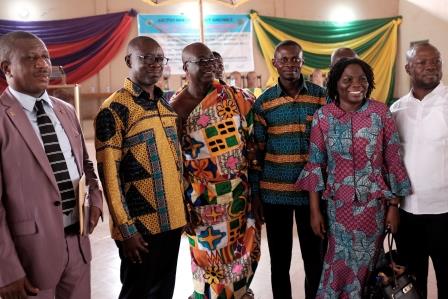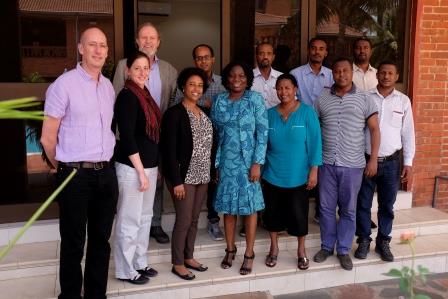A team representing government and NGOs from Ethiopia joined a visit to Ghana to learn about planning for achieving the Sustainable Development Goals for WASH.
Published on: 22/03/2018
This blog was prepared by John Butterworth, IRC WASH, and Laura Brunson, Programme Director at the Millennium Water Alliance.
The district of Asutifi North in Ghana is literally sitting on a gold mine. Located 300 km north-west of Accra in the Brong Ahafo region near the town of Kenyasi, the mine produces 350,000 ounces of gold a year (or ten tonnes) according to its owner, Newmont. A lot of this wealth leaves the district but the mine employs 2,500 employees and contractors and the Newmont Ahafo Development Foundation aims to ensure that gold mining benefits the local community. It invests 1 USD per ounce of ounce of gold sold and 1% net profits.

The district assembly in Asutifi North has been developing a master plan for its Full WASH Coverage Initiative to provide safe water and sanitation for all 80,000 residents of the district. This plan is its own gold mine in a different sense. It includes ideas that the district and its development partners seek to exploit to bring meaningful change to water, sanitation, hygiene, health and well-being. The wider aim is to work out how to achieve Full WASH coverage and contribute to attainment of the Sustainable Development Goals (SDGs) 6.1 and 6.2 in the country. As one of the first districts in Ghana to engage in this type of long-term planning, the initiative seeks to collect evidence on how to bring about significant change, will share lessons and will provide encouragement on how this might be done elsewhere.
As well as all local leaders, the launch of the initiative attracted professionals from Uganda, Burkina Faso and Ethiopia, all seeking to find answers to a similar question: how to strengthen the local government-led systems for WASH services delivery? The Conrad N. Hilton Foundation has been supporting these efforts through its Safe Water Strategy and is backing the initiative with catalytic financing and ideas in 6 focus countries. In Ethiopia, the effort is being led by the Millennium Water Alliance (involving Care, Catholic Relief Services, WaterAid, Helvetas, World Vision and Food for the Hungry) with the support of IRC WASH. The Ethiopian delegation that MWA and IRC WASH took along to learn about the Asutifi North experience included representatives of all these organisations and the regional government of Amhara.

One of the big takeaways from Asutifi North was that getting the partnership right is vital and that this requires a lot of initial investment. Ato Yimer Habtie, Deputy Bureau Head of the Bureau of Water Irrigation and Energy in Amhara Region reflected on the strong partnership between the government, NGOs and donors and suggested its replication in Ethiopia. NGO representatives also appreciated the way that the partnership has been built and were excited by the programming around systems strengthening.
In Ghana, the group that has come together includes the Asutifi North District Assembly, IRC, the Safe Water Network, World Vision International, Netcentric Campaigns, Aquaya Institute, the US Centers for Disease Control and Prevention (CDC), Newmont Ahafo Development Foundation, GIZ, and Water.org Inc as well as traditional authorities, CSOs and the local private sector. All these partners bring different perspectives and skills. This kind of partnership means a lot of meetings and a lot of discussions to develop a shared vision and activities. But now there is a widely owned plan that the district planning officer, technical staff and local leaders are all equally passionate about. There is something agreed that the partners can commit to and work towards delivering.
The MWA in Ethiopia is working on a similar process to develop strategic WASH plans to deliver on the SDGs in three districts in Amhara Region (Dera, Farta and North Mecha). These plans are expected to include delivering basic access to services to the unserved while at the same time, driving up service standards to meet national and international goals. New service delivery models such as rural water utilities, moving towards more professionalization in water services delivery, finding new solutions to poor water quality and building the capacity of government are all ideas that are expected to be included.
If successful, these plans will help districts to attract resources and provide the local vision and collaboration needed to deliver on WASH SDG expectations. In 2015/16, the entire Ethiopian WASH sector was estimated to have had a budget of just over 500 million USD. But projections by the Water Sector Working group have suggested 6 times that level of finance or 3 billion USD might be needed for new capital investments, while continuing to spend the current level of resourcing on operations and maintenance. Those 10 tonnes of gold from the Ahafo mine are worth 460 million USD a year. Ethiopia will need to find a different way than gold mining to put all the needed financing in place, but the new strategic plans are expected to show the way.
At IRC we have strong opinions and we value honest and frank discussion, so you won't be surprised to hear that not all the opinions on this site represent our official policy.